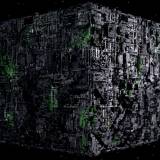All Saturn Games In Order: Special - The Hydlide Problem
By borgmaster 3 Comments
NOTE: This is a post ostensibly about Hydlide. As such, we are obviously under a Hydlide Warning. This is the most severe exposure to Hydlide possible without playing the games themselves. Intellectually vulnerable members of the community should proceed only at their own risk.
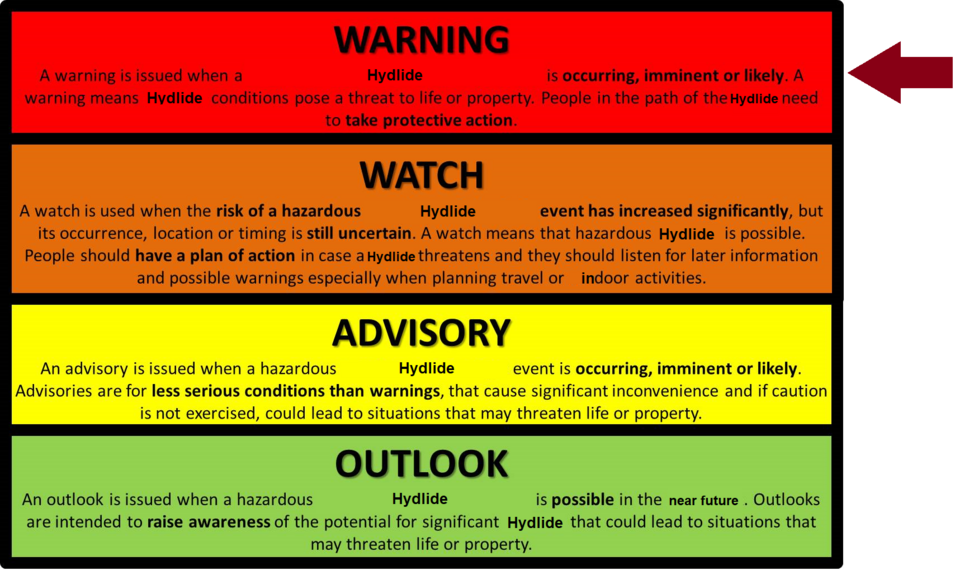
----------------------------------------------------------------------------------------------------
The Hydlide series of video games consists of four entries, with the first release in 1984 and the (hopefully) final release in 1995. None of these games exactly set the world on fire, but they were noteworthy enough to leave a controversial legacy that has been debated online by weird nerds ever since. This is because there have been claims that the Hydlide games, especially 1 and 3, were influential in the development of JRPG game design. This claim is made to counterbalance the accusations that the games in this series are all terrible and/or worthless. I shall join the weird internet nerds who have come before me in this debate. But before diving in, I want to address some of the questions that you, the reader, might have:
Q: OH GOD WHY?!
A: You'll have to read to the end if you really want that answer.
Q: Are you an authoritative source?
A: Not even a little. In fact, if you know of any authoritative sources that aren't HardcoreGaming101, let me know.
Q: Do you have any biases towards the Hydlide series?
A: I have recently made public and baseless insinuations that the development studio behind the Hydlide series was funded by the Japanese mafia. That should be enough to let you know where my opinion stands.
With that out of the way, let's start at the beginning. And I do mean the beginning. Most of the debate around Hydlide concerns the origins of the JRPG genre. To properly confront that topic, we need to establish some context.
----------------------------------------------------------------------------------------------------
Where It All Came From
Looking back, it seems that Role-Play Gaming evolved from earlier table-top gaming, which itself evolved from even earlier strategy gaming. Starting there, the most common and reductively cited earliest example of strategy gaming is Chaturanga. Seemingly developed over the course of the middle of the first millennium CE in the Gupta Empire, it is the ancient predecessor of various board games such as Chess and Shogi. Honestly though, every ancient civilization developed their own strategic/logical competitive games. There's intuitive reasoning to that statement: every early society conducted warfare, and the guys whose job it was to win those wars would have wanted to exercise their strategic and tactical thinking during times of peace, thus some kind of intellectual exercise(s) in strategy would get developed. Anyway, the ancient forms of chess were the games that gained international popularity during the early second millennium CE, thus becoming the earliest common touchpoint in game design.
After we yadda-yadda our way through the late medieval and early modern periods, we end up with a trend among European nobility to play increasingly more complicated variations on chess in an attempt to more accurately model real-world military maneuvers. This is the period where board games give way to what we'd call Wargaming. This trend among annoyingly foppish dorks culminated in the early nineteenth century with the first versions of Kriegsspiel. This was the brainchild of the dorkiest of wargame dorks, George Leopold von Reisswitz, a Prussian baron, and then his son of the same name and title. When we think of hardcore tabletop wargaming, this is where that came from. Axis & Allies, Warhammer, and the wargames going on in military staff colleges are all direct descendants of this game. Surprisingly, the complicated and rules heavy game where grown dudes played with little toys and dice on large custom map boards for hours on end didn't initially catch on outside of the Prussian nobility. I will say though, some of the royal Kriegsspiel sets that got made in the 1800's are a hobbyist’s dream come true.

This would all be a dead-end if it weren't for the swift and shocking slaughter of the imperial French armies at the hands of Prussia in the Franco-Prussian War of 1870. As a reminder, this is the war immediately after which Otto von Bismarck declared, "This isn't even my final form!" and created the German Empire. This was seen as the most interesting military action since the end of Napoleon 55 years earlier. That led to military nerds from industrial societies the world over to carefully scrutinize and emulate every hobby and interest of the German general staff. Imagine the most obsessive fanboys you can think of and combine that with the image of guys with muttonchops wearing stiff collars. One of the consequences of this was that the Kriegsspiel ruleset was translated and adapted to the English-speaking world by the 1880's.
Initially, those Kriegsspiel variations were played only among military officers, the biggest military nerds, and friends. Interest in Wargaming among wider intellectual audiences slowly grew until the wide publication of simplified rulesets began in the first decade of the twentieth century. The most prominent example I found was written by H.G. Wells, of all people, and was titled Little Wars: a game for boys from twelve years of age to one hundred and fifty and for that more intelligent sort of girl who likes boys' games and books. I include that entire title because it is the most Victorian sentence I have ever read. I'm personally surprised it took that long for wargames to get sold to children; when I think of an audience that would be most amenable to games with a lot of complicated rules which are played using little toys and dice on a large map, I immediately think of pre-pubescent boys. I only later consider emotionally stunted adults such as myself or Helmut von Moltke.
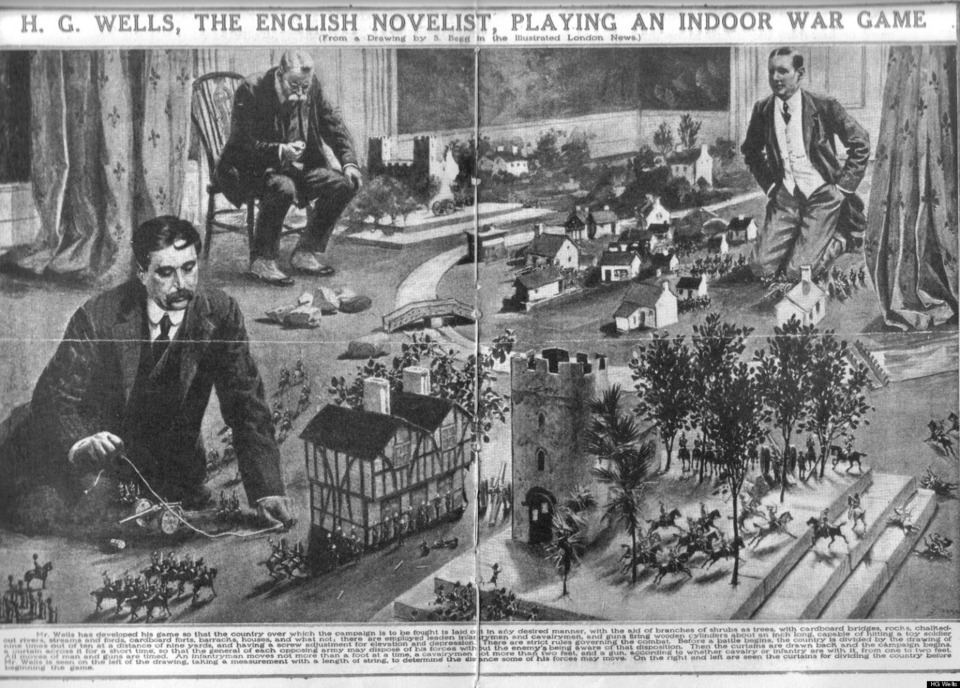
Trends in civilian Wargaming in the decades after that point get messy. Things went very badly for all of humanity for about thirty or so years, and a lot of the boys who grew up with any given ruleset ended up getting turned to mulch on some godforsaken battlefield before being able to spread their ruleset to younger boys. Consistent and widely played wargames become easier to track starting in the late 1950s. Production of detailed miniatures and enthusiast magazines began in the U.S by 1960. I've seen a guy named Jack Scruby get credited for that.
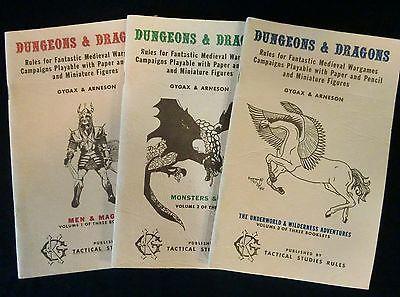
It's at this point that Wargaming exploded in popularity among teen nerds all over the English-speaking world. One of those early enthusiasts was Gary Gygax. By the early 1970's, he and Dave Arneson were separately in business as wargame designers and convention organizers. Somehow, the collaboration between these two resulted in the first published instance of a ruleset in which the individual miniatures were given names and went on series of internally consistent adventures. They also threw in a ton of legally questionable Tolkien references, because everyone who grew up as a teen nerd in the 50's and 60's did that. Published in 1974, Dungeons & Dragons quickly became an indie hit among the dorkier Wargaming enthusiasts. The story of D&D is large, complex, and extensively documented. For our purposes, we should turn our attention to the effect this release had on wider nerd culture. The creation and development of the Role-Playing Game genre as an offshoot of Wargaming occurred at a rapid pace throughout the 1970's. The size of the RPG community went from hundreds to thousands to tens and hundreds of thousands of players across North America and Europe over the course of only a few years.
----------------------------------------------------------------------------------------------------
What Does This Have To Do With Video Games?
Within a couple of years of the release of D&D, a variety of enthusiastic young delinquents began programming small dungeon crawling campaigns onto mainframe computers at their scholastic institutions. When you stop to think about it, this was an obvious thing to do. Original Wargaming required someone to play the role of an umpire during the play sessions. This umpire had the responsibility of being intimately familiar with the rules and thus resolving rules disagreements between the competing players. Nerd arguments tend to spiral out of control if not resolved quickly and decisively. D&D inherited that role in a modified form as the Dungeon Master, who was not only the umpire but also the lore master. It's easy to consider the benefits of having a hardcoded, automated Dungeon Master running a pre-determined campaign. And that's precisely the thinking that happened semi-independently across the US.
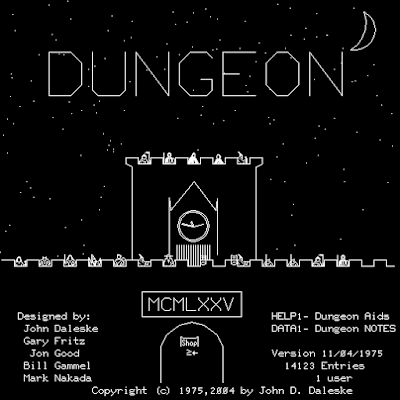
The possibilities for wide exposure to these games were extremely limited, being located on large, institutional mainframes. Though it didn't take long after the advent of personal computing for RPGs to follow. The first truly notable one of these is Temple of Apshai, released for early PCs in the summer of 1979. I'll get into the design features of this and other games a little later. The wild west of the early computer gaming market takes hold of the situation after this point. While I'll only focus in on the truly notable titles, know that were an uncountable number of small-batch games getting made and sold in rapid succession, though most of them were knockoffs of clones of knockoffs that are extremely difficult to track from our current era. The remaining truly notable western computer RPGs of the early-80's are the big three that would go on to form the foundation of the entire genre: Ultima, Wizardry, and Rogue. The below timeline will give a better sense of the timing of these games, but in summary both Ultima and Wizardry were commercially available in most US cities and Rogue was famous within the University of California system by the end of 1981.

Turning our attention across the Pacific, this all begs the question of when Japanese developers got in on the fun. This is a controversial subject with no clear answer. The development of RPG video games in Japan likely didn't follow from the same source as in the West since the earliest tabletop RPGs in Japan aren't recorded until 1982 at the absolute earliest. This conflicts with the earliest known Japanese developed dungeon crawler, Underground Exploration, which was released for the PC-8801 in March 1982. Things get a bit nebulous after that, with the only thing I can say with confidence being that multiple basic Dungeon Crawlers were developed primarily by Koei and PonyCanyon during the rest of 1982 and 1983. The settings in these games tended to stray from the high fantasy trappings of western cRPGs, possibly due to the lack of influence from D&D. Such different themes included Egyptian Ruins, Space, Feudal Japan, literally Mission: Impossible, and various modern-day pornographic settings (because that had to be in here somewhere). We don't see the first confirmable American-developed RPG in Japan until the beginning of 1984 with The Black Onyx.
The lateness of official American participation in the Japanese cRPG market implies that there was some unofficial conceptual pollination going on in the years before 1982. The way this happened could boil down to something as simple as someone flying across the ocean with a copy of Wizardry in their suitcase. Or perhaps Japanese students were exposed to those earlier mainframe RPGs while studying overseas. There doesn't seem to be any way to know what really happened. What we do know is that matters began to pick up steam in 1984. The launch of Tower of Druaga in Japanese arcades in the June put dungeon-crawling concepts in front of more eyes than before while also showcasing the revenue potential of the genre. This is soon followed by the release of multiple proto-Action RPGs for Japanese PCs in the Fall of that year: Dragon Slayer, Courageous Perseus, and Hydlide. I've included a timeline below for reference.
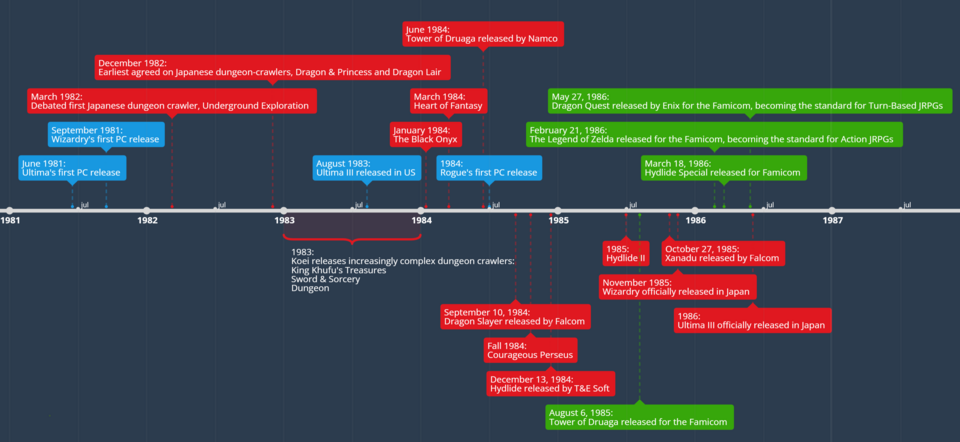
After the RPG releases of 1984, developments in the genre picked up considerably in 1985 and 1986. A version of Tower of Druaga was released in August '85 for the most popular home console at the time, the Nintendo Famicom, to noticeable commercial success. Also in 1985, both Dragon Slayer and Hydlide saw sequels released on Japanese PCs, American cRPGs were getting official releases in Japan, and the overall market for cRPGs was booming. From this environment the two most important games in the development of the JPRG genre were released for the Famicom in the first half of 1986. These were The Legend of Zelda and Dragon Quest, which set the gold standard for Action and Turn-Based RPG design in Japan. For practical purposes, that is the point where I would say JRPGs truly begin.
----------------------------------------------------------------------------------------------------
The Hydlide Question
Now, where does Hydlide fit into this? As I mentioned before, there were two whole Hydlide games released before 1986, alongside the initial entries in Falcom's somewhat more successful Dragon Slayer franchise. The president of T&E Soft at the time has been quoted saying that Hydlide sold one-million copies combined from all of its PC versions. That's highly unfortunate if true, but I have found no way to verify that number. Nor am I able to get a sense of the commercial success of Hydlide II, because it was quickly forgotten in the wake of The Legend of Zelda, which was released only four months later. As I mentioned at the beginning, the reason why these games have not been forgotten is due to the many claims over the years of their influence on more notable games such as Zelda, Dragon Quest, and Ys. There has also been talk of several famous game designers such as Hideo Kojima and Hideki Kamiya having been exposed to Hydlide at some point in the '80's. So, is Hydlide worthy of acknowledgement as one of the most influential RPGs? Looking at the series and its place in the history or RPG development, I would say the answer is a hard NO. I'm going to have to go further into the weeds to explain what the arguments for its influence are and why I don't believe them, so let's rewind back to 1979.
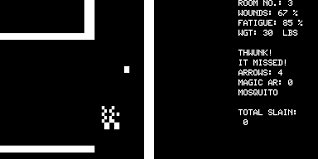
Temple of Apshai is what we would consider a very basic dungeon crawler. You roll character stats, purchase equipment, and wander through the dungeon killing monsters and looting treasure. The stats, experience system, and equipment are straight from D&D. The game is played from a top-down view with movement and combat happening in the D&D style of turn-based gameplay. There's a basic stamina and encumbrance system in there as well. This all results in the player wondering through the small game levels until getting offed by a mosquito or something. It wasn't much of an improvement over the mainframe dungeon crawlers that came before it, with the main innovation being that it could be played at home by a much larger audience. For our purposes, this is the starting point of cRPG design.
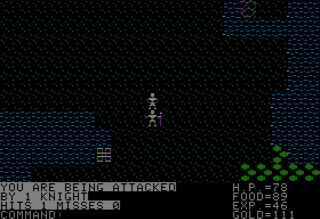
When we jump forward to 1981, we get Ultima and Wizardry. Let's start with Wizardry because it's easier to explain. This is another D&D inspired dungeon crawler, but significantly more sophisticated than Temple of Apshai. It improves on that formula by having multiple party members, first-person vector graphics, multiple character classes, more items and equipment, a magic system, more detailed character stats, a recognizable turn-based combat system, improved sprites, and a defined quest: kill the wizard. Ultima is a bit more involved to define. It makes use of the recently invented overworld idea, features simplified combat where you bump into enemies, has towns that you can wander around with NPCs that can be talked to, contains multiple dungeons, you go to SPACE, and acquire multiple means of transportation and quest items to eventually reach a final boss, who is also a wizard. The dungeons are shown in first person vector graphics like Wizardry, but the overworld and towns are top-down and sprite-based. Ultima is probably the single most important RPG ever made, from a design perspective. These are the foundational games for all western and eastern RPGs; to such an extent that you could reductively claim that Dragon Quest is just Ultima with Wizardry's combat.
As I said earlier, it isn't known what kind of contact Japanese developers had with American produced cRPGs. What we can know is that Dragon Lair and The Dragon & Princess were released in late 1982 in Japan. Dragon Lair seems to be a simplified knock-off of Temple of Apshai and might have been made by Americans. The simplifications are mainly around inventory management and character stats. Otherwise, it's a top-down dungeon crawler where you start off in a town to buy equipment before going into the one dungeon. That dungeon uses a simple top-down view with functionally the same combat system as Temple of Apshai. The Dragon & Princess on the other hand, seems to be a proto-turn-based tactics RPG, created by Koei when they weren't churning out smut. You create a party of adventurers, wander around a text-based city, and get into battles in an overworld. Those battles seem to work like an extremely simple Fire Emblem. There's also a rudimentary story involving both a dragon and a princess with a variety of NPCs to talk with. I'm including a diagram below where I try to keep track of a timeline of game features. Hopefully it helps keep everything in context.
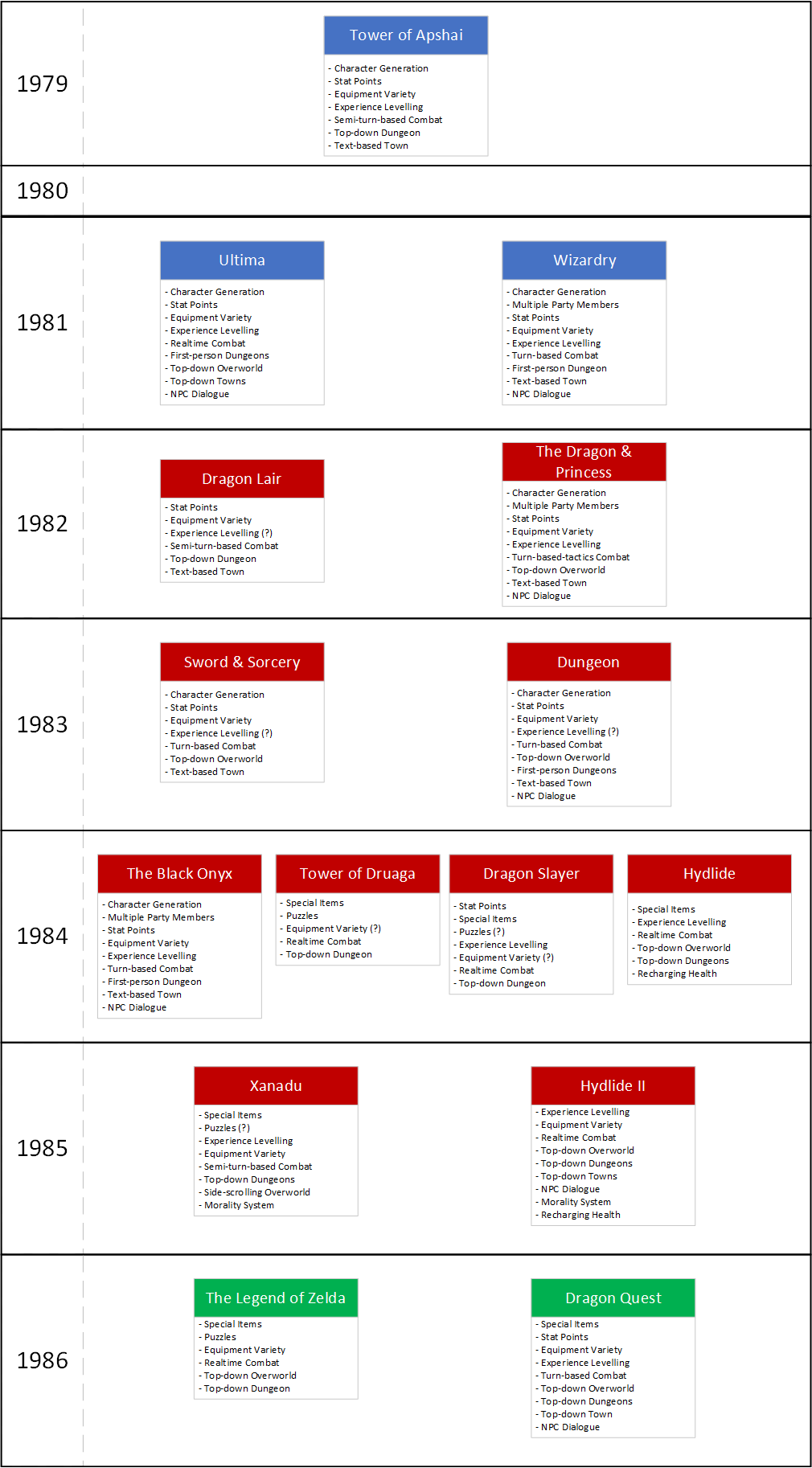
Over the course of 1983, Japan saw a variety of dungeon crawler and RPG/Adventure game hybrids. Those games are still hard to track down and evaluate, but a few examples include Sword & Sorcery, King Khufu's Treasure, Panorama Toh, and Dungeon. These games generally continue to mix and match the feature sets seen in Ultima and Wizardry. If anything, the course of Japanese cRPG development in 1983 shows an increasing familiarity with RPG design concepts and a gradually widening market for those types of games. This is the last time where I will note that throughout 1982 and '83, there were several pornographic games released with RPG elements. Those games aren't especially good or titillating, so you can look those up on your own time if you're curious.

It's once we get into 1984 that development really kicks into gear. We start that year with The Black Onyx, which for the sake of brevity is an almost exact Wizardry knock-off. That's fair enough, I suppose, as Wizardry was still far out from an official release on Japanese PCs. We then move onto the early summer, with Tower of Druaga. This game presages Gauntlet as much as anything else. It's a fully action-oriented top-down dungeon crawl, where you traverse a series of maze-like floors killing enemies and finding the exit. There isn't really any inventory stuff going on, no levelling or character generation; other than the action, there are some obscure puzzles and special items to collect that serve as permanent power-ups. This simplification was necessary to make the game feasible for arcade-style play. Both games were successful for their respective platforms. The Black Onyx became the best-selling Japanese cRPG of it's time and Tower of Druaga was one of the top arcade games of the year, which is where the real money was in game development back then.
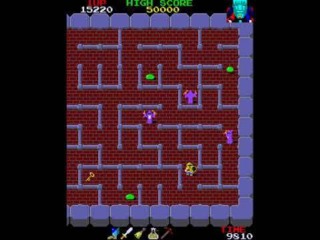
The success of those games turned a lot of heads in Japanese game development, and it was at this point when the floodgates opened. The most notable releases in the first wave of games following Druaga are Dragon Slayer and Hydlide. Falcom's Dragon Slayer is important because it created a franchise that would lead to both the invention of side-scrolling RPGs with Xanadu and the prolific Legend of Heroes series. Hydlide is notable because, well…that's what we're here to talk about.
Hydlide was officially released on December 14, 1984, for the PC-6001 and PC-8801. The PC-6001 version is not something that anyone should want to imagine, so we'll only consider the PC-8801 version. In this game you play as some guy named Jim who must collect three fairies and reassemble them into a princess, sort of like in Resident Evil Village. To do this, Jim travels around a small overworld and delves into a few caves to collect random junk to complete his quest. There are no NPCs, no real inventory, and no in-game economy. There is an experience system that only goes to nine levels. Any other character upgrades are collected through special items collected at specific points on the map. The small variety of monsters, which are the sole inhabitants of the world, only give experience up to a certain level. The slimes in the starting area only give experience up through level two, and so on for the rest. The combat follows the Ultima method of real-time bumping and doesn't have a lot going on. Since there is no inventory, player health recharges slowly over time when standing still. There are a handful of annoying bosses along the way, culminating in a fight with the big bad. The path of items to collect and locations to visit are meant to be done in a specific, uncommunicated order. The enemies are also informally level-gated in a way that is also only discovered through trial and error. This was a common design philosophy at the time and can still be found in the sadistic output of From Software. The experience with the game consists entirely of grinding for levels and figuring out where to go. This game has been referred to as a smaller, boring version of Legend of Zelda for reasons that will be obvious later.
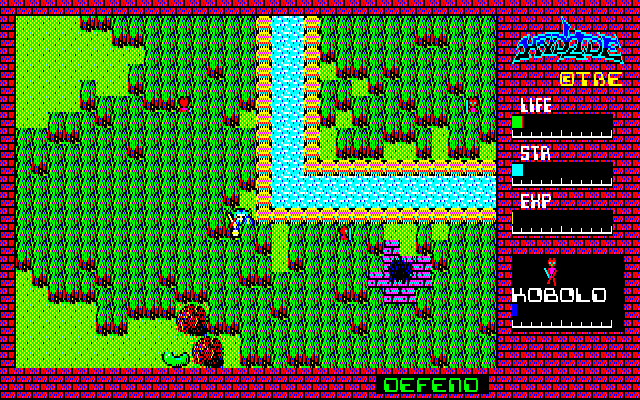
----------------------------------------------------------------------------------------------------
Why talk about Hydlide?
So, why is this little piece of nothing so notable? I have seen it given credit for the following:
- Inspiring Dragon Quest and/or The Legend of Zelda
- Inventing regenerating health
- Being the first JRPG
- Influencing any prominent Japanese developer you can name
Let's address each of these in turn.
The line that gets put forward the most often is that Hydlide served as a direct inspiration for either The Legend of Zelda or Dragon Quest, and thus the entirety of the JRPG genre. This seems to be a result of Hydlide being the first of those early Japanese cRPGs to receive a console release, and the only one to get released outside of Japan. Looking at the history of RPG development in Japan, none of the concepts or features used in both Hydlide and Zelda/Dragon Quest originated with Hydlide. With Dragon Quest, the design there has just about nothing to do with Hydlide. As I wrote earlier, that game can be reductively classified as Ultima with Wizardry's combat. Furthermore, Tower of Druaga is the source of the kind of top-down action dungeon-crawling seen in both Hydlide and Zelda. Hydlide can be classified as a half-assed Druaga with an overworld, and Zelda as a much deeper Druaga with an overworld. Adding an overworld to Druaga is an obvious idea for anyone who had been previously exposed to cRPGs, which is seen by looking at Hydlide's contemporary competitors, Dragon Slayer and Courageous Perseus. Dragon Slayer takes place in a single, open dungeon map that might as well be an overworld and it also takes gameplay cues from Druaga. I haven't discussed Courageous Perseus yet because nothing ever resulted from it, but it did come out in late '84 and contains many of the same ideas as Hydlide. It has an overworld, the same combat system, a similarly punishing levelling curve, and a similar quest to Hydlide. I am personally of the belief that this game could have filled a similar niche if Hydlide had not been released. As such, nothing about Hydlide was necessary in the development of the JRPG genre.

While we're on this topic, we can cross off any claims about the Hydlide series having a significant influence on later game designers. You could dig up interviews or quotes where some famous Japanese game designer (Hideki Kamiya is the most popular example) mentions having played Hydlide in their youth. This is taken as evidence that Hydlide served as an inspiration for that designer's work. This is a fallacious claim without seeing the specific game concepts used in Hydlide incorporated into the works by those designers. By analogy, James Cameron could have seen Plan 9 From Outer Space in his youth, but that wouldn't make that movie an inspiration for Aliens. This type of argument for a game's influence is usually wrong, and in this case, it is certainly wrong as nothing uniquely done by Hydlide can be seen as a basis in the work of later, greater designers.
We can also throw out any claims that Hydlide was the first JRPG. This argument tends to be made out of ignorance. We have already seen that there was an active RPG scene in Japan starting in 1982. There is a discussion to be had to define at which point Japanese developed RPGs became recognizable as JRPGs, but Hydlide does nothing to merit a place in that conversation.

Finally, the most compelling argument that I have seen is that Hydlide is important for inventing and popularizing the idea of the regenerating health system. This is compelling because I have not found an earlier game which uses that feature, though I invite anyone to correct me with an example. Even if this was the first game to do it, I wouldn't give it credit for the modern prevalence of regenerating health in games. Looking at the direct aftermath of Hydlide and its sequels, the only game that I could find adopting this mechanic is 1987's Ys. Released around the same time as Hydlide 3, Falcom seemingly created Ys as a direct reaction to the Hydlide series. I see it as an answer to the question, "What if Hydlide was any good?" Since Ys still exists as an active franchise and Hydlide is long dead, I would say that it successfully squelched Falcom's main competition in B-tier JRPG development. Other than that, Hydlide's regenerating health seems to have been a dead-end. We don't see any developers making much use of the concept until the turn of the century with western shooters. I find it highly unlikely that the boys at Bungie were big on Hydlide when developing Halo: Combat Evolved. At best, we see here an instance of a gameplay system that was invented independently in different places at different times.
If the traditional arguments for the relevance of Hydlide and its sequels are wrong, then why did it develop any kind of cultural cache to begin with? Why did Hydlide become a series, and why did it not fall down the memory hole along with games like Courageous Perseus and Panorama Toh?
----------------------------------------------------------------------------------------------------
The Hydlide Problem
I can see two main reasons for why Hydlide made it as far as it did: console ports and timing. Explaining this further, Hydlide was released for the Famicom in March 1986, between the releases of Zelda and Dragon Quest. This made it one of the earliest dungeon crawlers on the system, along with Zelda and an earlier port of Druaga. This also made it the first of the previously existing cRPGs in Japan to make the jump to console. I think it was in a better position to do so than its peers due to its basic simplicity mapping more obviously to the two-button Famicom controller. These things would be the reason for its sales success. There is a claim from the series creator, Tokihiro Naito, that the game sold one million copies across all PC versions and another million on the Famicom/NES. Those numbers would make it as successful as the original Dragon Quest or Final Fantasy, which I find HIGHLY unlikely. Disregarding those numbers, we can determine that it was at least successful enough to justify ports and sequels. To help make sense of those sequels and ports, I've included a timeline below.

The timing of the original PC-8801 version of Hydlide happened at a good moment to ride the coattails of Tower of Druaga, and the Famicom version released at the perfect moment to ride an increased interest in action RPGs after the launch of Zelda. The later games in the series would not have that same luck, which is why I think it faded as quickly as it did. Hydlide II came out in '85 in direct competition with Dragon Slayer II: Xanadu (or just Xanadu) which was a more successful, creative, and important game. This is despite Hydlide II being an improvement over the original in every way possible, though that isn't saying much. The series then proved unable to successfully keep up with the monumental developments of 1986 and '87. When Hydlide 3 came out in 1987, it was again a noticeable improvement along the same creative lines as the previous game. This third entry would include a day/night cycle, multiple towns, an encumbrance system, and a significantly larger game world. Yet, it still featured bump combat and continued to feel like a cheap Ultima knock-off. This came out the same year as Final Fantasy, Dragon Quest II, DDS: Megami Tensei, and Ys. The direction of Hydlide 3 tried to "innovate" on the wrong things, which proved to be a dead-end.
T&E Soft would try to cash-in on the series after Hydlide 3 came and went with minimal fanfare. They ported an improved version of that game to the Famicom and later to the Mega Drive. In fact, the Mega Drive release, renamed to Super Hydlide, was the first action-RPG to appear on that console, beating out Sword of Vermillion by three months and Sorcerian (aka Dragon Slayer 5) by five months. That gambit seems to have somewhat helped improve the fortunes of that series, though not enough to make more entries immediately worthwhile. The North American ports of Hydlide and Super Hydlide in 1989 and 1990, respectively, became infamous failures. For the first game, its design and production value were insultingly obsolete by 1989. Later, even though Super Hydlide managed to be the first action-RPG for the Genesis, it came out only one month after Phantasy Star II, which could not have been flattering.
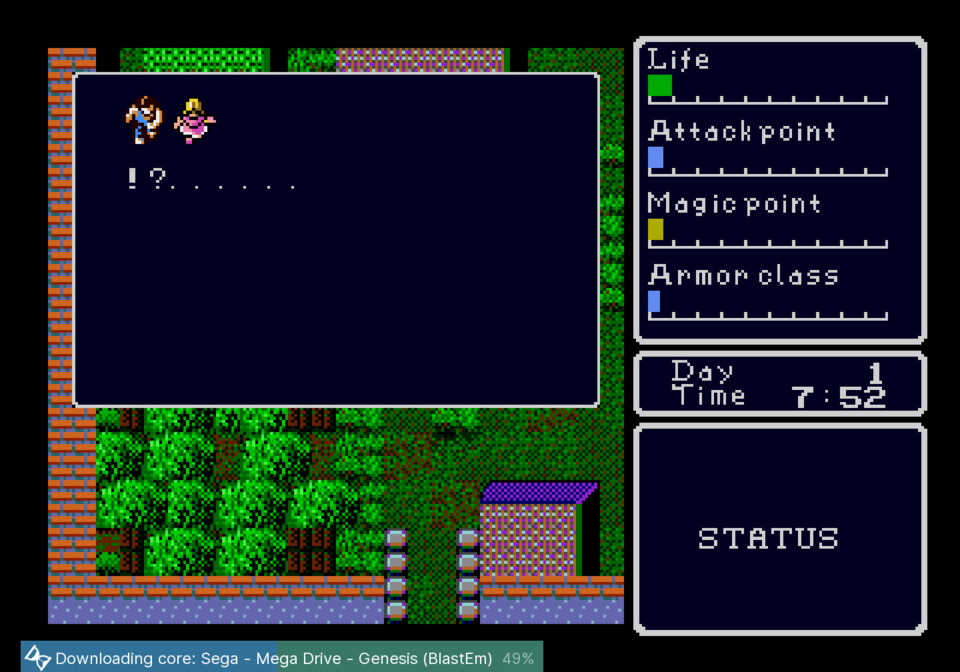
The series went dormant for a while as T&E Soft was busy keeping the lights on with their True Golf series. The whole thing would come to an ignominious end with Virtual Hydlide in 1995. If we don't count the 3DO (which we should never do) then this would have been the first RPG of any kind for a 32-bit system, beating out Suikoden by half a year. They kept positioning entries in this series at moments when they would be one of very few options available in that genre for various platforms, yet the games still ultimately failed. This brings us to the elephant in the room with which even the most enthusiastic Hydlide apologist must grapple: all four games in the series are abysmally terrible.
I've briefly described the original Hydlide above and I've previously looked at Virtual Hydlide. I will say for the sake of brevity that the middle two games in the series are not any better than those entries. It is truly incredible that there is an entire franchise spanning a decade where each game is so completely miserable. Every visual, music clip, enemy, puzzle, boss fight, dungeon, piece of text, and gameplay system are done poorly. No moment in any of the Hydlide games are enjoyable. Every aspect of every game is wrong-headed. It would take a small book to adequately describe the failings of each of these games in turn. Yet the thing that makes them truly hazardous is that, for any given game, once you have figured out the one correct way to play it to completion, it won't seem that bad. Once you've made the effort to solve the riddle of how to interact with the things, you begin to like them. I felt a little of it after completing Virtual Hydlide, at which point I thought, "you know, I could do that again if I needed to." Another example can be seen during Mike Uyama's speedrun of Super Hydlide at AGDQ 2020. Spending enough time with this series can lead to a person getting Hydlide-pilled if they aren't careful.
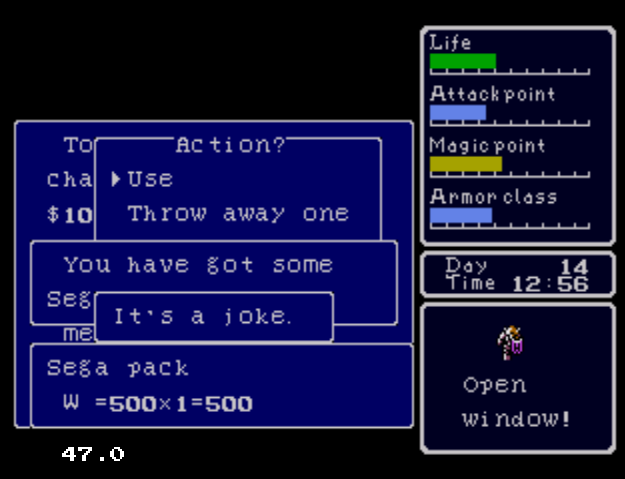
I have established that the games in the Hydlide series did not meaningfully contribute to the development of the JRPG genre specifically, or video games generally. The series' reputation was the beneficiary of some favorably timed releases in Japan, and infamously timed releases in the rest of the world. They are also terrible according to every possible measure, both in their own times and in hindsight. Yet, there is some kind of attractive power that they hold on anyone who has put enough hours into any given entry. I could go on for several more paragraphs about how these games serve as a nostalgic totem for all the worst impulses in old game design, but I'm tired. The Hydlide series deserves to be only the object of scorn and derision if anything at all. If you encounter anyone making excuses for this series, it is enough to know that they are wrong and it is too late for them, focus only on saving yourself.
----------------------------------------------------------------------------------------------------
Sources
- A large number of Wikipedia articles
- HarcoreGaming101, especially the 'Dark Age of JRPGs' article series
- Towerofretrogame, for reference
- Various YouTube playthroughs and summaries of games that I did not want to get running. Shout out to all the creators whose channels I forgot to write down.
- Personal experience with: Ultima 1, 2, and 3; Wizardry; Dragon Quest; The Legend of Zelda; Hydlide Special; Super Hydlide; Virtual Hydlide; and many more old RPGs.
- All else was revealed to me through divine inspiration
Finally, a special thanks to Timeline Maker for having an exploitable trial period and Microsoft Visio for being easy to pirate.
----------------------------------------------------------------------------------------------------
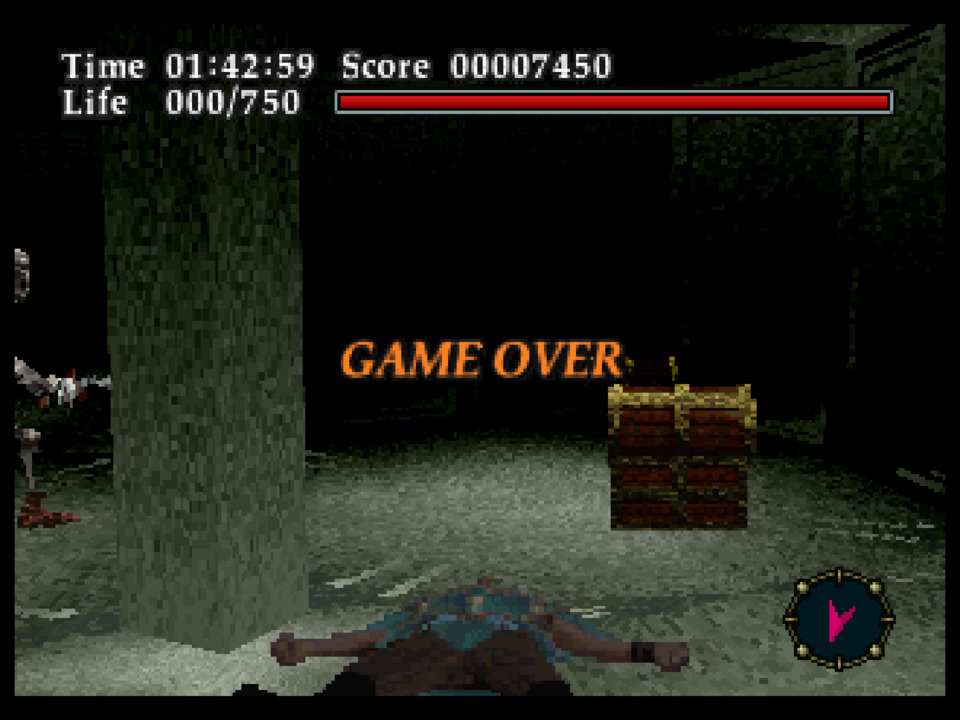
Next time we will get back on track with the October 1995 Saturn releases: NHL All-Star Hockey, World Series Baseball, Off-World Interceptor Extreme, Romance of the Three Kingdoms IV: Wall of Fire, SimCity 2000, and Black Fire. I have a (not really) dark secret to share regarding one of these games, so check back in a week to find out what that is!
